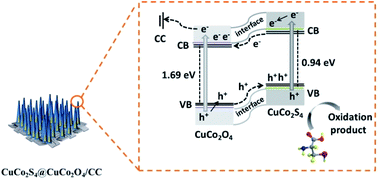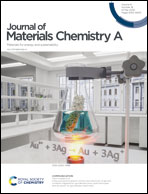An in situ engineered CuCo2S4@CuCo2O4 heterojunction with an O–S interpenetrated interface as a photoanode for selective photoelectrochemical bioanalysis†
Abstract
In this work, an integrated electrode strategy is put forward to enhance photoexcited charge separation, in which a CuCo2S4@CuCo2O4 nanoneedle array heterojunction with an O–S interpenetrated interface is synthesized directly on a carbon cloth (CC) substrate via a hydrothermal process followed by a controlled in situ exterior sulfurization method. CuCo2S4@CuCo2O4 as a binder-free photoanode exhibits a high sensitive photocurrent response due to the unique design and construction of the integrated electrode. The vertically aligned CuCo2S4@CuCo2O4 nanoneedle architecture with wide open channels improves light scattering and harvesting, and maintains abundant active edge sites for spatially separating redox reactions. In particular, the superior co-presence of an O–S interpenetrated interface in both components of the electrode gradually formed in the sulfurization process act as a smooth bridge to promote photoexcited charge shuttling with a low barrier, and thoroughly promote electron/hole separation, further boosting the photoelectrocatalytic activity of the electrode. A novel photoelectrochemical (PEC) sensor with CuCo2S4@CuCo2O4/CC as a photoanode was constructed for the selective detection of L-Cysteine (L-Cys) without any biomolecule auxiliary. This PEC platform is effectively shielded from the interference of glutathione (GSH) and other coexisting amino acids due to the formation of a Cu–S bond, steric effects and its different redox properties. The applicability of this method was also investigated by the determination of L-Cys in human serum, urine and injection samples, with satisfactory results. This work provides a feasible strategy for the fabrication of an integrated electrode, and offers an insight into the exploitation of PEC for bioanalytical purposes.



 Please wait while we load your content...
Please wait while we load your content...